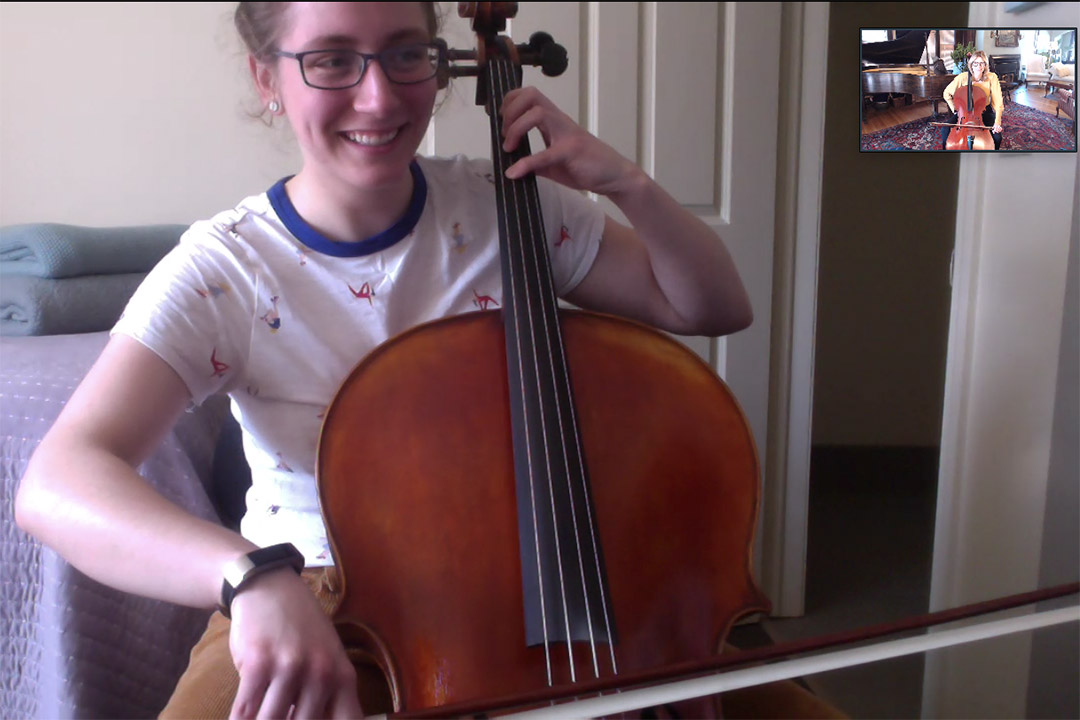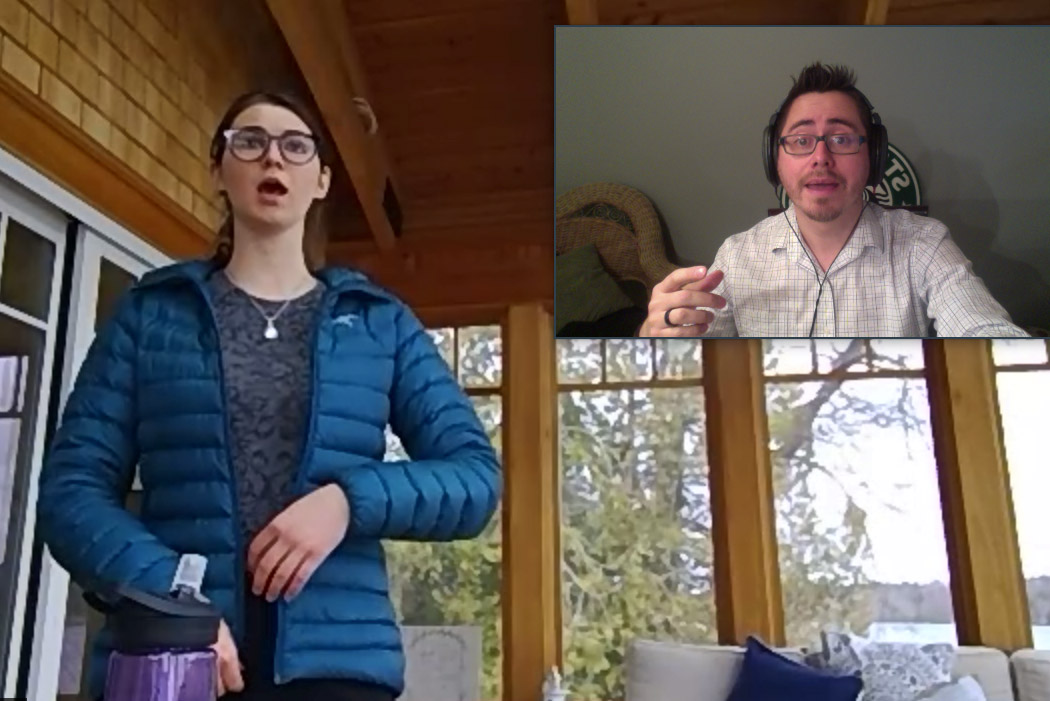RIT’s music education doesn’t miss a beat with social distancing
Students receive one-on-one instruction via video conferencing for course credit
Brianna Hicken, a second-year American Sign Language-English interpretation major from Rochester, Minn., has an online cello lesson with an adjunct professor Joan Kinsella in RIT’s Department of Performing Arts and Visual Culture.
With social distancing in place, faculty and students at Rochester Institute of Technology are finding ways to continue private music instruction with some ingenuity and video conferencing.
More than 100 students are continuing their one-on-one music lessons from home, using the technology to practice their voices, pianos, guitars, flutes, saxophones, cellos, violins, harmonicas, trombones and tubas.
“So far, the response from my students has been pretty positive,” said Pablo Willey-Bustos, an adjunct vocal professor in RIT’s Department of Performing Arts and Visual Culture, who teaches 30-minute lessons to 26 students each week. Once it was decided lessons would continue online, he told students what platform they’d be using and what they needed to do to prepare.
“Aside from being in a separate room, for the most part, the functionality of the lesson is there. We are able to keep a lot of that integrity. We just need to sometimes slow down and listen,” he said.
That’s because there’s a small time lapse on their platform, Zoom, which makes real time accompaniment difficult. So he, with help from colleague Priscilla Yuen, who teaches piano, records any accompaniment needed and sends it to the students at home so they can play it on their end during their lessons.
Willey-Bustos said he’s used distance learning a few times in the past, “but not to the extent I’m doing now. While it requires a whole new level of preparation, we’re making it work. I jokingly refer to it as opera karaoke.”
Skyler Herman, a first-year software engineering major from Montville, N.J., is adjusting to his video conferencing lessons with Willey-Bustos.
“I have no doubt that as time goes on things will become as normal as they can be given our current situation,” said Herman, who is a member of RIT Players and RIT Singers. “I’m still enjoying my vocal lessons. They really start my day off well and keep me positive.”
Emily Mahoney, a third-year chemistry major also is continuing her vocal lessons with Willey-Bustos. She practices on her screened-in porch from her Cazenovia, N.Y., home so her brother can make business calls.
Emily Mahoney, a third-year chemistry major, is continuing her vocal lessons from her home in Cazenovia, N.Y., with Willey-Bustos, an adjunct vocal professor in RIT’s Department of Performing Arts and Visual Culture.
“I am enjoying our voice lessons and I think they are working very well,” Mahoney said. “Warmups are more challenging because he is unable to play with me all the way through, but it is helping me improve my pitch recognition and response, so honestly it is a positive. I am really happy he is still providing the voice lessons since I have more space at home where I can sing, so it’s even more beneficial here.”
Joan Kinsella now teaches cello from her Rochester living room to seven RIT students in their homes.
“Of course personal contact is the best and hearing the music in person is far superior, but it’s amazing this substitute is a really great way to teach music,” she said.
When it was determined students might not be returning to campus after spring break due to Coronavirus, and some may be home without instruments, Kinsella began to think creatively to continue their lessons by having them listen to different interpretations of a piece. Fortunately, all of her students got their instruments.
The first week of lessons came off without a hitch. “It’s great to be able to connect with the students and keep the music going,” she said.
And she’s discovering some advantages to the online lessons.
For instance, when students are looking at a screen, it’s often easier to analyze a hand or bow position. “You can get right up to the webcam and show the bow in the screen in a frame with that particular viewpoint. It’s easier for students to understand,” she said.
Another advantage of online learning is that the lessons are more efficient, with students prepared and ready to go without having to tune up or rosin their bows, she said.
“When I finish one lesson, I go right into the next lesson for the student in my virtual waiting room,” Kinsella said. “There’s no lag time. There’s something about starting right away that’s nice. It translates into this energy flow with positive momentum.”
Brianna Hicken, a second-year American Sign Language-English interpretation major from Rochester, Minn., is grateful she can continue practicing cello at RIT, which she started playing in middle school.
“It’s definitely different playing remotely, but I’m trying to find the positive in it,” she said. “It does make better use of our time. I don’t have to unpack my instrument. I’m already tuned and ready to go.”
Normally she’d sit next to Kinsella and look at her hand position in a mirror in front of them. Lessons via video now means she sees Kinsella on the computer screen.
Hicken is a member of the RIT Philharmonic Orchestra and in lieu of their spring concert, members may find a way to record themselves and have each recording edited together on a video.
“We’re trying to find a way to keep playing music together,” Hicken said. “You’ve got to do what you’ve got to do to get through this.”
Despite making video conferencing work for music lessons, Kinsella and her students are eager to see the traditional method of lessons return.
“The range of a cello is so dramatic and often harder to hear,” she said. “Even with a good microphone you don’t get all the nuances and quality of sound you would hear in person.”
The situation has also shown the willingness of her colleagues to collaborate by sharing tips to teach online.
“It’s really nice that in a time of crisis, people want to work together and help each other,” she said.








